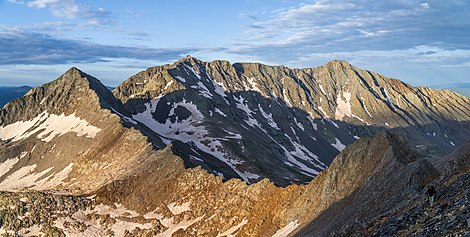Mount Wilson (Colorado)
| Mount Wilson | |
|---|---|
 Mount Wilson | |
| Highest point | |
| Elevation | 14,252 ft (4,344 m)[1] NAVD88 |
| Prominence | 4,024 ft (1,227 m)[1] |
| Isolation | 33.0 mi (53.1 km)[1] |
| Listing | |
| Coordinates | 37°50′21″N 107°59′29″W / 37.8391607°N 107.9914581°W[2] |
| Geography | |
Location in Colorado | |
| Location | class 3[3] |
Mount Wilson is the
The peak was named for
Climbing
Mount Wilson is ranked among the top ten hardest of the Colorado
A popular, though long, outing for expert climbers is the mile-long ridge connecting Mount Wilson to
Geology and history
Mount Wilson, and the rest of the San Miguel Mountains, are made up of a large, irregular
The Mount Wilson region became the site of intense mining activity, particularly for silver, in the early 1880s. The most famous of these mines was the Silver Pick Mine, which gave its name to Silver Pick Basin, just north of Navajo Basin.
Glaciers and permafrost
Mount Wilson contains four small
During the Pleistocene glaciers were much more extensive than today, covering the whole summit plateau[9] In glaciations previous to the Wisconsinian, it is generally thought that summit ice caps were even more extensive and joined to form the "San Miguel Glacier" with icecaps in the San Juan Mountains.[10]
Climate
| Climate data for Mount Wilson 37.8368 N, 107.9914 W, Elevation: 13,606 ft (4,147 m) (1991–2020 normals) | |||||||||||||
|---|---|---|---|---|---|---|---|---|---|---|---|---|---|
| Month | Jan | Feb | Mar | Apr | May | Jun | Jul | Aug | Sep | Oct | Nov | Dec | Year |
| Mean daily maximum °F (°C) | 24.4 (−4.2) |
24.1 (−4.4) |
28.5 (−1.9) |
33.6 (0.9) |
42.1 (5.6) |
53.7 (12.1) |
58.4 (14.7) |
56.2 (13.4) |
50.4 (10.2) |
40.9 (4.9) |
31.1 (−0.5) |
24.6 (−4.1) |
39.0 (3.9) |
| Daily mean °F (°C) | 12.4 (−10.9) |
11.7 (−11.3) |
15.8 (−9.0) |
20.4 (−6.4) |
29.0 (−1.7) |
39.6 (4.2) |
45.1 (7.3) |
43.4 (6.3) |
37.3 (2.9) |
28.2 (−2.1) |
19.4 (−7.0) |
13.0 (−10.6) |
26.3 (−3.2) |
| Mean daily minimum °F (°C) | 0.4 (−17.6) |
−0.6 (−18.1) |
3.0 (−16.1) |
7.3 (−13.7) |
15.8 (−9.0) |
25.4 (−3.7) |
31.7 (−0.2) |
30.6 (−0.8) |
24.2 (−4.3) |
15.5 (−9.2) |
7.8 (−13.4) |
1.3 (−17.1) |
13.5 (−10.3) |
| Average precipitation inches (mm) | 4.91 (125) |
4.43 (113) |
4.51 (115) |
4.94 (125) |
4.10 (104) |
1.17 (30) |
3.21 (82) |
3.21 (82) |
3.07 (78) |
3.32 (84) |
4.43 (113) |
4.89 (124) |
46.19 (1,175) |
| Source: PRISM Climate Group[11] | |||||||||||||
Historical names
- Glacier Mountain
- Mount Wilson – 1906 [2]
See also

Notes
- NGVD 29 to NAVD 88.
References
- ^ a b c d e f "Mount Wilson, Colorado". Peakbagger.com. Retrieved January 2, 2016.
- ^ a b c d "Mount Wilson". Geographic Names Information System. United States Geological Survey, United States Department of the Interior. Retrieved October 21, 2014.
- ^ "Mt. Wilson Routes". 14ers.com.
- ^ ISBN 0-87108-850-9, pp. 231–239.
- ISBN 0-9628867-2-6, pp. 160–165.
- ISBN 0-87842-105-X, p. 245.
- ^ Glaciers of Colorado
- ^ See Péwé, Troy L.; "Alpine permafrost in the United States: A Review"; in Arctic and Alpine Research; vol. 15, no. 2 (May 1983); pp. 145–156
- ^ Atwood, Wallace Walter and Mather, Kirtley Fletcher; Physiography and quaternary geology of the San Juan Mountains, Colorado; p. 74
- ^ Atwood and Mather; Physiography and quaternary geology of the San Juan Mountains; p. 72
- ^ "PRISM Climate Group, Oregon State University". PRISM Climate Group, Oregon State University. Retrieved October 10, 2023.
To find the table data on the PRISM website, start by clicking Coordinates (under Location); copy Latitude and Longitude figures from top of table; click Zoom to location; click Precipitation, Minimum temp, Mean temp, Maximum temp; click 30-year normals, 1991-2020; click 800m; click Retrieve Time Series button.

